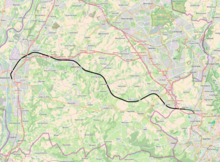Aachen-Maastricht Railway Company
The Aachen-Maastricht Railway Company (AMEG) was a Prussian railway company that was founded in 1845 at the same time as its Dutch sister company, the "Aken-Maastrichtsche Spoorweg-Maatschappij", for the purpose of building a railway line from Aachen to Maastricht .
This line was finally put into operation in 1853 as the first Dutch route to go abroad and was used to transport people and goods both for travelers between Aachen and Maastricht and for the farmers from the region to transport their goods and as an industrial railway for the Transport of the coal from the surrounding mines in the Aachen-Limburg district to their destinations. This new railway line now provides connections to the already well-developed Belgian and French railway network as well as to the network of the Rheinische Eisenbahn-Gesellschaft and the Royal Directorate of the Aachen-Düsseldorf-Ruhrorter Eisenbahn or its successor organization, the Bergisch-Märkische Eisenbahn-Gesellschaft .
history
The first plans to build a rail link between Aachen and the port of Antwerp via Maastricht and Hasselt had been presented to the public by James Cockerill in 1831 , but they were rejected because it was assumed that Cockerill wanted to gain personal advantages through the route himself was the owner of numerous coal mines in the Dutch province of Limburg . Thanks to the personal commitment of David Hansemann five years after Cockerill's death, the plans were taken up again in 1843 and the route planning was specified. The Chamber of Commerce and the City Council of Aachen supported the establishment of an interest group which, together with Maastricht representatives, set up a joint commission for the establishment of a Dutch and Prussian railway company. On July 14th and 15th, 1845, the founding meeting of the two companies with equal rights took place in Aachen City Hall , which from then on called themselves “Aachen-Maastricht Railway Company” and “Aken-Maastrichtsche Spoorweg-Maatschappij”. These then received a concession from the Prussian government on January 30, 1846 and from the Dutch government on February 23, 1846 for the construction of a railway line between Aachen and Maastricht, along with branch lines tailored to requirements.
To reduce the risk of the construction and operation of this railway line, the Dutch King Wilhelm II granted the Prussian AMEG the right to use the Domaniale Mijn hard coal mine in Kerkrade , from which the company received the coal it needed for its locomotives, for 99 years. The Domanial coal mine was then owned by the company for the duration of the concession until May 10, 1945. Lengthy negotiations about the inner-city planning of the route on the Aachen side, the necessary land purchases on the Dutch side and the different customs regulations and the associated redesign of some stations meant that the railway line could only be opened on October 23, 1853. At the same time, the Dutch sister company received another concession for a line from Maastricht to Hasselt, which was opened in 1856 and created a connection to the existing Hasselt- Landen line near Leuven . In those early years, the fleet already consisted of eight locomotives, 16 passenger cars and 224 freight cars, most of which were supplied by Cockerill-Sambre and Borsig .
Just a few years later, however, the Prussian Aachen-Maastricht Railway Company got into financial difficulties and from August 1, 1867 had to lease the Aachen-Maastricht route network to the private Belgian railway company "Grand Central Belge". However, this made it possible for AMEG to continue its expansion strategy. Then, with a concession from 1871, it was able to connect the Domaniale Mijn hard coal mine with a new 8 km long branch line via Simpelveld to the main line, which went into operation on August 1, 1872 and which gave this mine a necessary economic boost. Initially the coal wagons were pulled by horses until the traction was switched to locomotives in 1880. In Simpelveld, the coal was then transferred to the standard-gauge freight cars of the Aachen-Maastricht Railway.
After the “Grand Central Belge” was nationalized as a Belgian railway company in 1897 and the Dutch state railroad took over the Dutch section of the line a year later, the Prussian railway administration also bought the German part of the line from AMEG. The AMEG no longer owned a railway line except for the feeder that was economically and structurally connected to Domaniale Mijn and was then dissolved as an independent railway company, with the remaining railway line being co-managed by Domaniale Mijn under its director Otto von Pelser-Berensberg . The usufructuary right to the Domaniale Mijn, originally due to the Prussian Aachen-Maastricht Railway Company, was transferred in 1917 to the still existing sister company "Aken-Maastrichtsche Spoorweg-Maatschappij", which in turn was liquidated in 1921 and taken over by the state in 1924.
literature
- Heimatfreunde des Heydener Ländchen 1989 eV (Ed.): The Aachen-Maastricht Railway - A documentation of its history from 1830-1992. Aachen, 1992
Web links
- History of the Aachen-Simpelveld-Valkenburg-Maastricht line
- The Aachen-Maastricht Railway Company
- Aachen railway history
- Founder's share no. 18.855 from the Aachen-Maastricht Railway Company
- Founder's share no. 2459

